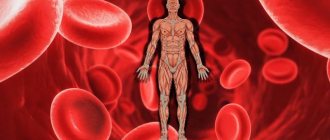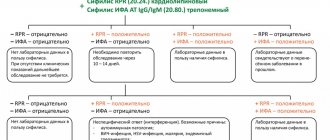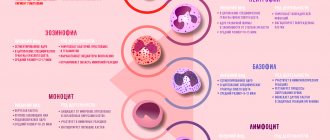The indicator aspartate aminotransferase, or abbreviated as AST, AST, AST (all abbreviations are identical and denote one concept) is one of several enzymes that takes part in the daily synthesis and metabolism of amino acids contained in membrane cells and tissues.
AST is not found in all organs of the body; for the most part it is the liver, heart and skeletal muscles, since the largest number of metabolic processes occur in these tissues.
The normal AST level is quite low, which means that its increase in the body indicates damage to any organs of the body. In the process of dying, the cells are destroyed, and the AST enzyme comes out of them and enters the blood, increasing in quantity in the blood.
Important! Analysis of the AST enzyme helps to identify and recognize cell death in the liver and heart. If other organs are damaged, the indicator does not increase.
What does the AST blood test mean?
AST, AST, AST or aspartate aminotransferase is the same concept, denoting one of the enzymes of protein metabolism in the body. This enzyme is responsible for the synthesis of amino acids that make up cell membranes and tissues. AST is not active in all organs. Moreover, this type of aminotransferases can be classified as specific enzymes, the excess activity of which indicates a fairly narrow range of pathological conditions. Most of AST is found in the myocardium (heart muscle), hepatocytes (liver tissue), neurons of the brain and muscle tissue of skeletal muscles. This is explained by a fairly high level of metabolic processes in them and the need for maximum cell adaptability to maintain its structure. This enzyme helps them with this.
As long as the structure of cells containing AST is not disturbed, the amount of this enzyme in the plasma is minimal and does not exceed normal limits. As soon as their integrity is disrupted, this leads to its excessive release into the systemic circulation. This phenomenon will be recorded in the form of a natural increase in AST activity. The dependence should be directly proportional: the more active the cytolysis, the higher the AST level. The time after the onset of cell destruction is important - the longer it is, the less enzyme activity in the plasma will be.
When prescribing a biochemical blood test, they imply an analysis of the enzymatic activity of the plasma, among other indicators of which AST is necessarily examined. This requires venous blood, which is obtained by puncture of one of the peripheral veins in the amount of 15-20 milliliters. Its centrifugation allows you to separate the plasma from the formed elements, which then lends itself to various chemical reactions. During their course, AST activity in the blood is determined.
An AST study allows you to determine the presence of cell destruction (cytolysis) of the myocardium or liver. If other organs are affected, this indicator does not increase. Very often it is prescribed not only to confirm damage to specific tissues, but to carry out differential diagnosis or exclude cardiac and liver pathologies!
What is alanine aminotransferase (ALAT)
The functioning of the human body is ensured by multiple chemical processes that are both cyclical and interconnected, continuous and consistent. Enzymes play a major role in blood filtration and digestion systems. Alanine aminotransferase (ALAT) is the main liver enzyme involved in amino acid metabolism. Most of the enzyme is found in the liver, with small amounts in the kidneys, cardiac and skeletal muscles.
Alanine itself is important as a source of rapid glucose production to nourish the brain and central nervous system. Studying the level of ALT and AST in the blood greatly facilitates the diagnosis and prognosis of severe diseases and damage to the liver, heart and pancreas.
The specificity of ALT makes it possible to differentiate diseases according to the degree of excess of standard values, which is very important when symptoms are weak and the manifestations of various diseases are similar. Using ALT readings in combination with other tests, the doctor can determine the extent of organ damage and make a prognosis for the course of the disease.
When is an AST test prescribed?
According to international protocols and standards for diagnosing diseases, a biochemical blood test, including an indicator of AST activity, is mandatory for many types of somatic pathology.
It can be:
- Acute and chronic diseases of the heart and circulatory system;
- Any liver pathology;
- Poisoning and intoxication;
- Kidney damage with renal failure;
- Infectious pathology;
- Purulent-septic conditions;
- Various types of jaundice and disorders of bilirubin metabolism;
- Signs of ascites and portal hypertension;
- Encephalopathy of unknown origin;
- Autoimmune diseases;
- Acute pathology of the abdominal organs of a surgical nature;
- Any forms of cholelithiasis and bile outflow disorders;
- Pancreatic necrosis and chronic pancreatitis;
- Endocrine pathology;
- Allergic skin diseases;
- Malignant tumors of any location and suspicion of their metastasis;
- Aggressive and long-term treatment with chemotherapy, antibiotics and other toxic drugs;
- Preoperative preparation for any complex interventions;
- Assessment of the dynamics and effectiveness of treatment of liver and heart diseases;
- Injuries to the chest and abdomen with suspected contusion of the heart or liver;
Who is prescribed an ALT test?
An ALT test is prescribed in the presence of certain symptoms and factors:
Symptoms of liver disease:
- weakness, lack of appetite, nausea and vomiting;
- abdominal pain, jaundice;
- dark urine and light-colored feces.
Risk factors for liver disease:
- previous hepatitis,
- alcohol addiction,
- diabetes and obesity,
- hereditary reasons
- taking medications that have an aggressive effect on the liver.
ALT blood test is carried out for the following purposes:
- checking for possible liver damage due to injury;
- identification of drug and alcohol addiction within the framework of a set of interrelated indicators;
- assessment of the effect of anticholesterol therapy and a number of other drugs that are relatively toxic to the liver;
- Finding out the cause of jaundice in a patient - liver disease or blood dysfunction.
A patient who is prescribed an ALT test should inform his doctor about the presence of reasons that could reduce the accuracy of the test results:
- taking certain medications, dietary supplements and herbal infusions (oral contraceptives and aspirin, warfarin and paracetamol, infusions of valerian and echinacea);
- possible pregnancy;
- presence of allergies;
- completing a course of intramuscular injections;
- rehabilitation period after cardiac surgery or cardiac catheterization;
- active physical activity before the test.
The test is performed on the patient's venous blood and results can be available in approximately 12 hours.
Norm of AST in the blood
In order to correctly evaluate the obtained indicators of plasma enzymatic activity in relation to AST, you need to know its normal values. Most laboratories usually indicate the norm next to the result obtained. This is due to the fact that different reagents and methods can be used to determine the AST indicator. The types and standards given in the table are considered generally accepted.
| Determination method | Norm for men | Norm for women | Norm for children |
| Optical (in ME) | Up to 40-41 IU | Up to 34-35 IU | Up to 50 IU |
| Reitman-Frenkel reactions (in mcomol/(h/ml)) | 0,1-0,45 | 0,1-0,35 | 0,2-0,5 |
If a biochemical blood test yields AST values that do not exceed standard values, this indicates the normal functioning of the enzyme systems of the heart and liver and the preserved integrity of the cellular composition of these organs. If there are clinical symptoms of their damage, other specific markers (ALT, troponins, creatine phosphokinase, etc.) must be examined!
How to prepare for donating blood for “biochemistry”?
In order for the results to be as accurate as possible, you must follow the rules for preparing for a blood test for a biochemical study:
- Within two days, switch to a gentle diet - eliminate fatty, sweet, spicy, salty, smoked foods, and also give up alcohol, coffee and strong tea;
- The day before, refrain from any stressful procedures and activities for the body - baths and saunas, contrast showers, heavy physical activity;
- If you are taking medications, discuss with your doctor whether they will affect the test results;
- 6-12 hours before the BAC, you should not eat any food or smoke. You are only allowed to drink plain water.
Reasons for increased AST
Detection of an increase in AST, especially repeated, may indicate the following diseases:
- Acute myocardial infarction in the initial phases of its development. Based on the dynamics of the indicator, one can judge its extensiveness and recovery period;
- Closed and open heart injuries;
- Myocarditis of autoimmune or infectious origin;
- Acute and chronic viral hepatitis;
- Toxic liver damage from hepatotoxic poisons and drugs;
- Fatty and alcoholic hepatosis;
- Endogenous intoxications against the background of infectious and purulent-septic diseases of internal organs and soft tissues;
- Severe chronic heart failure;
- Cholestasis caused by a mechanical obstruction in the bile ducts (stones, tumors, congenital anomalies);
- Impaired hepatic blood flow and portal hypertension;
- Cirrhosis of the liver with preservation of intact areas of this organ. In decompensated cirrhosis, the enzymatic activity of plasma in relation to AST decreases due to the complete replacement of the liver with connective tissue;
- Metastases to the liver of malignant tumors;
- Primary cancer of the liver or bile ducts;
- Damage to the liver and heart in malignant forms of myeloblastic leukemia;
- Massive destruction of muscle tissue (myodystrophy, generalized myositis, crush syndrome, reperfusion syndrome against the background of restored blood flow in the ischemic limb;
Not every increase in AST should be perceived as a sign of cellular cytolysis. If the indicator is several units of measurement higher than normal values, this does not mean anything. An increase in AST two or more times higher than normal is of diagnostic significance.
In this regard we can talk about:
- Moderate increase (when AST increases five times);
- Average increase (when an increase in the indicator is recorded up to ten times higher than normal);
- Severe elevation (AST level is ten or more times higher than normal).
The main diagnostic value of AST is heart damage during a heart attack. The study is carried out dynamically with short time intervals (about an hour). Any changes in the indicator that exceed the norm, in doubtful cases, speak in favor of a heart attack!
ALT elevation levels
The standard ALT indicator as part of the diagnostic complex “blood biochemistry” may differ slightly in different laboratories, but on average the limits of this indicator for men are 10–40 U/l, for women – from 7 to 35 U/l. The criteria for differentiating diseases are levels of excess of the ALT norm:
Minor:
- taking medications and chemicals (antibiotics and barbiturates, chemotherapy and drugs),
- cirrhosis of the liver,
- fatty liver disease;
Moderate and medium:
- alcohol poisoning,
- some forms of hepatitis,
- growth problems in adolescents;
High:
- cancer tumor necrosis,
- viral hepatitis,
- state of shock.
How to lower AST in the blood?
People who are looking for an answer to a similar question need to clearly understand: an increase in AST is not an independent disease and therefore there are no separate measures to reduce it!
Since this sign signals the destruction of cells containing this enzyme (heart, liver, muscles), it is necessary to diagnose and treat diseases of these organs. Only healthy tissues will be able to function normally and bring all indicators of a biochemical blood test, including AST, back to normal.
It is necessary to clearly understand that an increase in AST is not the cause of the disease. This is its consequence. Therefore, only the elimination of the causative disease can interrupt the cause-and-effect relationship, which will be reflected in the normalization of AST activity and will become a criterion for victory over this disease. Any cases of increased aspartate aminotransferase are a reason to seek specialized medical help. This harmless and asymptomatic sign often hides serious chronic diseases that will only manifest themselves after some time.
Author of the article:
Mochalov Pavel Alexandrovich |
Doctor of Medical Sciences therapist Education: Moscow Medical Institute named after. I. M. Sechenov, specialty - “General Medicine” in 1991, in 1993 “Occupational diseases”, in 1996 “Therapy”. Our authors








